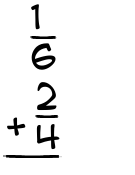What is 1/6 + 2/4?

|
This is how to add
|
||||||||||||||||||||||||||||||||
Step 1We still have different denominators (bottom numbers), though, so we need to get a common denominator. This will make the bottom numbers match. Multiply the denominators together first. Now, multiply each numerator by the other term's denominator. Now we multiply 1 by 4, and get 4, then we multiply 6 by 4 and get 24. Now for the second term. You multiply 2 by 6, and get 12, then multiply 6 by 4 and get 24. This gives us a new problem that looks like so:
|
||||||||||||||||||||||||||||||||
Step 2Since our denominators match, we can add the numerators. 4 + 12 = 16 So what's the answer so far?
|
||||||||||||||||||||||||||||||||
Step 3Can this fraction be reduced? First, we attempt to divide it by 2... Are both the numerator and the denominator evenly divisible by 2? Yes! So we reduce it:
Now, try the same number again. Are both the numerator and the denominator evenly divisible by 2? Yes! So we reduce it:
Now, try the same number again. Are both the numerator and the denominator evenly divisible by 2? Yes! So we reduce it:
Now, try the same number again. Nope. Try the next prime number, 3... No good. 3 is larger than 2. So we're done reducing. Congratulations! Here's your final answer to 1/6 + 2/4
|